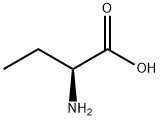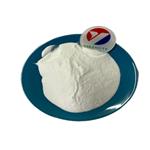Chemical Properties
White Crystalline Solid
Uses
L-(+)-2-Aminobutyric acid is used in the biosynthesis of nonribosomal peptides. It acts as a receptor antagonist. It is also used as a chiral reagent. Further, it is used in the determination of substrate of glutamyl cysteine acid synthase. In addition to this, it is also utilized as a drug intermediate.
Uses
aminobutyric acid is an amino acid with water-binding properties and possible anti-inflammatory capacities.
Definition
ChEBI: An optically active form of alpha-aminobutyric acid having L-configuration.
Synthesis Reference(s)
Journal of the American Chemical Society, 68, p. 450, 1946
DOI: 10.1021/ja01207a032
General Description
L-2-Aminobutyric acid is synthesized from L-threonine and L-aspartic acid through a ?-transamination reaction. It is an L-alanine analogue with an ethyl side chain.
Biochem/physiol Actions
L-α-Aminobutyric acid (AABA) is an isomer of the non-natural amino acid aminobutyric acid with activity in the γ-glutamyl cycle that regulates glutathione biosynthesis. Recently AABA has been studied as a supplement to in vitro maturation medium (NCSU 23 medium) for culture of oozytes and embryos. This product has been qualified for use in cell culture. AABA is also used as a substitute amino acid for alanine in studies on peptide function.
Synthesis
The preparation of l-2-aminobutyric acid (l-ABA) is mainly achieved by chemical synthesis or enzymatic conversion. In chemical methods, synthesis of l-ABA has been extensively reported, including ammonolysis of α-halogen acid, reduction reaction, ammoniation hydrolysis reaction and butanone acid reduction. However, the obvious disadvantages of chemical synthesis, such as poor selectivity, harsh reaction conditions, various byproducts, and the difficulty in separation and purification, limited its development. It is reported that l-ABA was synthesized in a transamination reaction from α-ketobutyric acid and l-aspartic acid as substrates using aromatic aminotransferase or produced from α-ketobutyric acid and benzylamine using ω-aminotransferase. l-ABA could also be produced from the reduction of α-keto acids with l-leucine dehydrogenase or glutamate dehydrogenase[1].
Purification Methods
Crystallise butyrine from aqueous EtOH, and the melting point depends on heating rate but has m 303o in a sealed tube. [Greenstein & Winitz The Chemistry of the Amino Acids J. Wiley, Vol 3 p 2399 IR: 2401 1961, Beilstein 4 III 1294, 4 IV 2584.]
References
[1] Xu, Jian-Miao et al. “Fermentative production of the unnatural amino acid L-2-aminobutyric acid based on metabolic engineering.” Microbial cell factories vol. 18,1 43. 28 Feb. 2019, doi:10.1186/s12934-019-1095-z.




